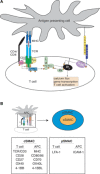T cell responses: naive to memory and everything in between
- PMID: 24292902
- PMCID: PMC4089090
- DOI: 10.1152/advan.00066.2013
T cell responses: naive to memory and everything in between
Figures




Similar articles
-
SnapShot: effector and memory T cell differentiation.Cell. 2009 Aug 7;138(3):606.e1-2. doi: 10.1016/j.cell.2009.07.020. Cell. 2009. PMID: 19665979 Free PMC article. No abstract available.
-
New insights into lymphocyte activation and differentiation.Curr Opin Immunol. 2013 Jun;25(3):297-9. doi: 10.1016/j.coi.2013.05.013. Epub 2013 Jun 5. Curr Opin Immunol. 2013. PMID: 23746790 No abstract available.
-
T cell memory.Annu Rev Immunol. 2002;20:551-79. doi: 10.1146/annurev.immunol.20.100101.151926. Epub 2001 Oct 4. Annu Rev Immunol. 2002. PMID: 11861612 Review.
-
T cell proliferation, differentiation, and restoration in lymphopenic individuals: for contributed volumes.Adv Exp Med Biol. 2002;512:135-9. doi: 10.1007/978-1-4615-0757-4_18. Adv Exp Med Biol. 2002. PMID: 12405197 Review. No abstract available.
-
Lifespan of lymphocytes.Immunol Res. 1995;14(1):1-12. doi: 10.1007/BF02918494. Immunol Res. 1995. PMID: 7561338 Review.
Cited by
-
Infection and Immune Memory: Variables in Robust Protection by Vaccines Against SARS-CoV-2.Front Immunol. 2021 May 11;12:660019. doi: 10.3389/fimmu.2021.660019. eCollection 2021. Front Immunol. 2021. PMID: 34046033 Free PMC article. Review.
-
Human CD8+ T Cells Exhibit a Shared Antigen Threshold for Different Effector Responses.J Immunol. 2020 Sep 15;205(6):1503-1512. doi: 10.4049/jimmunol.2000525. Epub 2020 Aug 17. J Immunol. 2020. PMID: 32817332 Free PMC article.
-
Analysis of Immune and Inflammation Characteristics of Atherosclerosis from Different Sample Sources.Oxid Med Cell Longev. 2022 Apr 25;2022:5491038. doi: 10.1155/2022/5491038. eCollection 2022. Oxid Med Cell Longev. 2022. PMID: 35509837 Free PMC article.
-
Paracrine costimulation of IFN-γ signaling by integrins modulates CD8 T cell differentiation.Proc Natl Acad Sci U S A. 2018 Nov 6;115(45):11585-11590. doi: 10.1073/pnas.1804556115. Epub 2018 Oct 22. Proc Natl Acad Sci U S A. 2018. PMID: 30348790 Free PMC article.
-
Advances in modular control of CAR-T therapy with adapter-mediated CARs.Adv Drug Deliv Rev. 2022 Aug;187:114358. doi: 10.1016/j.addr.2022.114358. Epub 2022 May 23. Adv Drug Deliv Rev. 2022. PMID: 35618140 Free PMC article. Review.
References
-
- Appleby MW, Gross JA, Cooke MP, Levin SD, Qian X, Perlmutter RM. Defective T cell receptor signaling in mice lacking the thymic isoform of p59fyn. Cell 70: 751–763, 1992 - PubMed
-
- Bacchetta R, Passerini L, Gambineri E, Dai M, Allan SE, Perroni L, Dagna-Bricarelli F, Sartirana C, Matthes-Martin S, Lawitschka A, Azzari C, Ziegler SF, Levings MK, Roncarolo MG. Defective regulatory and effector T cell functions in patients with FOXP3 mutations. J Clin Invest 116: 1713–1722, 2006 - PMC - PubMed
-
- Bachmann MF, Wolint P, Walton S, Schwarz K, Oxenius A. Differential role of IL-2R signaling for CD8+ T cell responses in acute and chronic viral infections. Eur J Immunol 37: 1502–1512, 2007 - PubMed
MeSH terms
Grants and funding
LinkOut - more resources
Full Text Sources
Other Literature Sources

